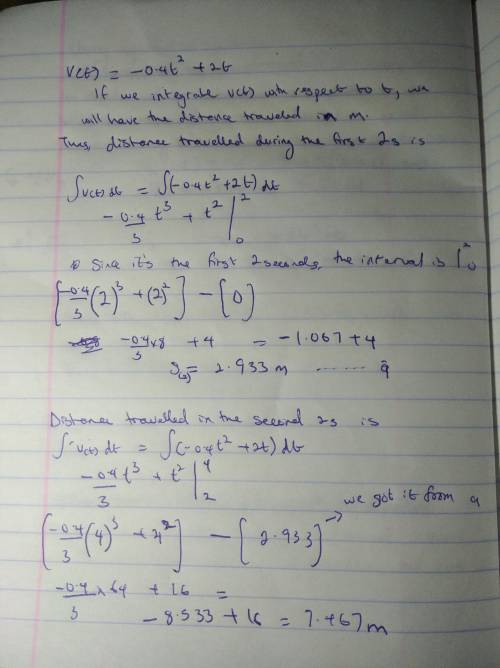
Physics, 20.07.2020 01:01 FIRENINJA117
A particle is released as part of an experiment. Its speed t seconds after release is given by v (t )equalsnegative 0.4 t squared plus 2 t, where v (t )is in meters per second. a) How far does the particle travel during the first 2 sec? b) How far does it travel during the second 2 sec?

Answers: 2
Another question on Physics

Physics, 22.06.2019 08:30
Pl asaaap ! match the term to the correct description. a type of wave that transfers energy where the particles in the medium move perpendicular to the direction in which the energy is traveling. a type of wave that transfers energy where the particles in the medium move parallel to the direction in which the energy is traveling. movement that is back and forth, like an equal sign = a type of wave that transfers energy where the particles in the medium move in a circle motion while the energy travels left or right. movement that is like a t transfers energy from one location to another 1. wave 2. parallel movement 3. perpendicular movement 4. transverse wave 5. longitudinal wave 6. surface wave
Answers: 1

Physics, 22.06.2019 18:00
Efficiency is the ratio of to for a system a)power in to power in b)power in to power out c) power out to power out d) power out to power in
Answers: 2

Physics, 22.06.2019 19:30
Amass m = 74 kg slides on a frictionless track that has a drop, followed by a loop-the-loop with radius r = 18.4 m and finally a flat straight section at the same height as the center of the loop (18.4 m off the ground). since the mass would not make it around the loop if released from the height of the top of the loop (do you know why? ) it must be released above the top of the loop-the-loop height. (assume the mass never leaves the smooth track at any point on its path.) 1. what is the minimum speed the block must have at the top of the loop to make it around the loop-the-loop without leaving the track? 2. what height above the ground must the mass begin to make it around the loop-the-loop? 3. if the mass has just enough speed to make it around the loop without leaving the track, what will its speed be at the bottom of the loop? 4. if the mass has just enough speed to make it around the loop without leaving the track, what is its speed at the final flat level (18.4 m off the ground)? 5. now a spring with spring constant k = 15600 n/m is used on the final flat surface to stop the mass. how far does the spring compress?
Answers: 3

Physics, 22.06.2019 23:00
Astronomers studying the planet of rhombus have detected sedimentary rock on its surface. one astronomer wonders if material in this sedimentary rock used to be in igneous rock deep in rhombus’s interior. can igneous rock become sedimentary rock? explain your answer.
Answers: 1
You know the right answer?
A particle is released as part of an experiment. Its speed t seconds after release is given by v (t...
Questions

Mathematics, 02.09.2019 08:30

Advanced Placement (AP), 02.09.2019 08:30


English, 02.09.2019 08:30






Biology, 02.09.2019 08:30

Social Studies, 02.09.2019 08:30




History, 02.09.2019 08:30

Biology, 02.09.2019 08:30



English, 02.09.2019 08:30




